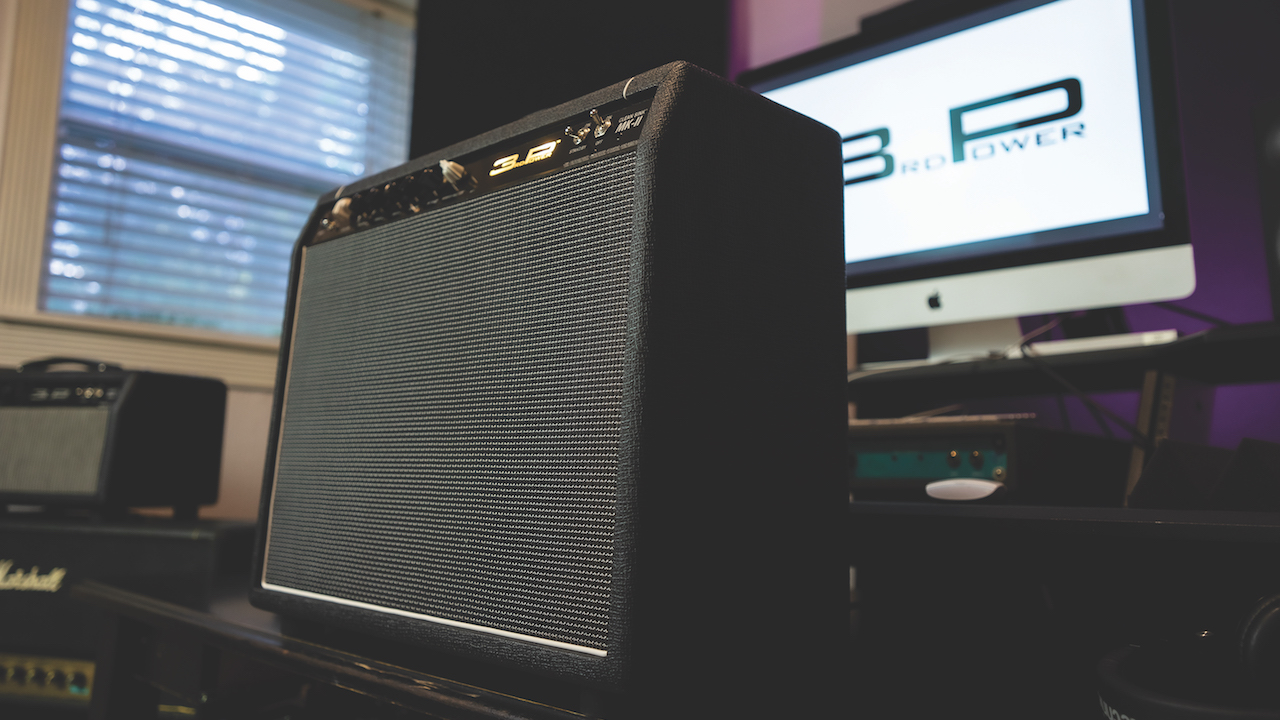The mission: create a multi-tone classic-sounding tube amp for the 21st century. 3rd Power founder Dylana Nova Scott on her inspiration behind the “optimal, gigable” Clean Sink MkII
“Players need inspiring tools to create and deliver their heart, soul and music to their audience That’s what 3rd Power does”: Discover the Clean Sink MkII, a game-changing tube combo with three blendable iconic amp tones

As moderns guitarists lean toward digital solutions in their quest for optimal amp tone, many tube-amp makers are redefining this 100-year-old technology to suit current-day demands. To that end, acclaimed Nashville-based brand 3rd Power offers up its Clean Sink MkII as the optimal, gigable, classic-clean amp, with stealth-like versatility for the 21st century.
A former touring and recording guitarist, 3rd Power’s founder and head designer Dylana Nova Scott has earned a stellar reputation for thinking outside the box to pack unprecedented versatility into tube amps that otherwise follow rather classic templates.
The company’s Kitchen Sink 6VEL, for example, seeks to run the gamut of American and British clean-to-dirty tones via a control panel far less dizzying than those of many foot-switchable, multi-channel amps. Likewise, the company’s now-deleted Dreamweaver and Dual Citizen straddled both side of the tonal pond with an authenticity that won many users.
An amp designed purely to achieve the world’s finest clean tones at usable stage and studio volumes might not, at first glance, appear to follow the same versatility premise.
However, there’s a lot of flexibility within the Clean Sink MkII’s control interface, thanks largely to three knobs that extend its voicing and volume capabilities beyond the standard gain and EQ controls. In addition to the traditional volume, treble, bass and reverb, it boasts controls for:

Voicing: With a range from AM to AC, the voicing control rolls continually between American/Fender and British/Vox, with a broad range of blendability in between. A two-way Normal/T-Boost switch alongside the single input further refines the Voxy reaches of its fully clockwise rotation.
HF Damp: This high-frequency cut control sweetens up the frequency range and avoids harsh highs (particularly useful when the amp is used onstage with in-ear monitors).
All the latest guitar news, interviews, lessons, reviews, deals and more, direct to your inbox!
Hybrid-Master: 3rd Power’s patented take on the master-volume control, it governs overall volume levels without altering basic gain and EQ responses.
The foundation for all this is an all-tube circuit with four 12AX7s in the preamp, reverb and phase-inverter stages, and two 6V6GTs in the output stage in Class AB fixed bias. Rectification is solid-state, and the power stage hits the output tubes pretty hard, delivering 425VDC at the plates for the clarity and headroom we associate with Fender’s high-plate-voltage 6V6 amps of the mid to late ’60s.
The combo cab measures 19.8 by 16 by 9.5 inches and weighs 31 pounds. The overall format is akin to the clean classic for club and studio, the Princeton Reverb, but as we’ve already seen there’s a whole lot more going on here.

If the Clean Sink MkII represents a paring down of the philosophy of the original Kitchen Sink — an amp that, as the name implies, sought to give players everything they could want, from clean to crunch to mean — it also embodies its do-it-all attitude, albeit limited to the clean side of the gain spectrum.
“Ever since we debuted the Kitchen Sink amplifier back in 2017, players have been reaching out to us asking if we’d ever make a lower-powered version of the separate channels,” Scott tells GP.
“We did that in the summer of 2019 with the Clean Sink and the Dirty Sink, which did well for us and made a lot of players happy. However, they had inherent production challenges as well as limitations to what the chassis and the enclosure could accommodate as far as future development.
“When the pandemic hit, supply-chain issues dictated that we look at our core amp models and streamline production based on materials and components that we could get on a consistent basis from our reliable suppliers.
“We streamlined our chassis to two versions: the Wooly Coats chassis, similar in size to a Fender Princeton, and the Kitchen Sink, our standard flagship mid-sized multichannel chassis that we’ve employed for the past 10 years.”
At the same time she was redesigning the two new chassis for a more efficient layout, Scott decided to make them from aluminum. This not only makes for a lighter amp but also brings its own sonic benefits, as aluminum has greater conductivity than steel.

“Aluminum chassis sound more open than steel chassis,” Scott reveals. “I know this because I built two identical amps, one on steel, one on aluminum. I recorded each one with the same tubes and the controls all set to the same metered values to remove as many variables as possible. The aluminum chassis was unquestionably more transparent and toneful than the steel chassis.”
In fact, many notable tube-amp designers have made the same observations; the legendary Ken Fischer of Trainwreck Circuits, for one, told me much the same thing in the early 2000s before he passed away.
Other advances in the MkII included improved ventilation throughout the chassis and LibraCAD design to accommodate tube-socket and component positioning for the future development of any conceivable amp.
A neater layout on the hand-wired turret board saves upwards of 24 inches of connecting wire and takes only seven hours to build rather than the 14 hours of the MkI circuit. Scott has also given the combo a “just right” cabinet that comfortably houses her favorite speaker — the Celestion Alnico Gold — while remaining compact and portable.
Aluminum chassis sound more open than steel chassis. I know this because I built two identical amps, one on steel, one on aluminum
While testing the Clean Sink MkII with a Telecaster, a Jazzmaster and a Les Paul, I immediately bonded with its rich, clear, articulate clean tones, and was seduced by its easy attainment of that often-elusive ability to be inspiringly euphonic without leaning on the aural crutch that distortion often provides.
Where so many modern nothing-but-clean amps (or amp channels) can sound sterile and soulless, the Clean Sink MkII does that magical thing that has kept us falling in love with vintage Princeton Reverbs, Deluxe Reverbs, AC15s and the like: Its ostensibly undistorted tones still feel extremely dynamic and playable and inspiring under the fingertips, while it issues the girth and dimension and harmonic swirl that help your playing stand out in the mix or onstage.
All that, and its ability to segue between the American and British versions thereof, is truly jaw-dropping. Scott’s voicing knob is an impressive feature indeed, and the mini toggle that jumps you from the warmer Normal channel AC tone to the brighter, bitier Top Boost rendition is the icing on the cake.

Just when this might all get a little too ice-picky, the HF Damp control comes to the rescue to tailor the treble content to ear-friendly proportions, and the Hybrid-Master — a 3rd Power feature that has impressed me in past reviews — really does taper the output levels to suit a variety of rooms without noticeably changing the amp’s tone.
The reverb sounds lush and multi-dimensional, too, although it might get deep and wet rather quickly for players who like just a touch of the effect in their tone.
With the volume maxed and the Hybrid-Master at noon or beyond, the Clean Sink MkII will deliver just a little edge-of-breakup clipping that eases into bluesy lead and rock and roll territory, but it also handles overdrive pedals very well when dialed back into cleaner realms.

A Wampler Tumnus Deluxe, a Victory the Duchess and a Tsakalis Six all interacted beautifully with the combo, and easily negated any desire for a foot-switchable lead channel or the like.
All in all, it’s just a great and versatile amp that’s beautifully suited to a wide range of playing needs today, and one that I will have trouble parting with.
“I’m passionate about tone,” Scott tells us, summing up her design philosophy. “I’m a three-times-patented inventor. I even enjoyed a professional recording and touring career in the ’80s and ’90s and have been working in the M.I. world since 1986.
“As the gear world has changed over the past four decades, I’ve been there along the way, and today is no different. Players need inspiring tools to create and deliver their heart, soul and music to their audience, without any loss in translation. That’s what I do. That’s what 3rd Power does.”
For more information on the Clean Sink MkII and 3rd Power's products, visit their website
Dave Hunter is a writer and consulting editor for Guitar Player magazine. His prolific output as author includes Fender 75 Years, The Guitar Amp Handbook, The British Amp Invasion, Ultimate Star Guitars, Guitar Effects Pedals, The Guitar Pickup Handbook, The Fender Telecaster and several other titles. Hunter is a former editor of The Guitar Magazine (UK), and a contributor to Vintage Guitar, Premier Guitar, The Connoisseur and other publications. A contributing essayist to the United States Library of Congress National Recording Preservation Board’s Permanent Archive, he lives in Kittery, ME, with his wife and their two children and fronts the bands A Different Engine and The Stereo Field.

